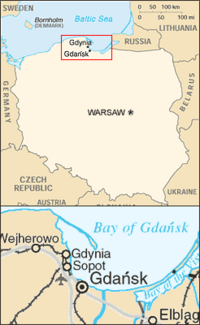- Worek Plan
-
The Worek Plan (or Operation Worek, Polish: Plan Worek, literally Plan Sack) was an operation of the Polish Navy in the first days of World War II, in which its five submarines formed a screen in order to prevent German naval forces from carrying out landings on the Polish coast, and to attack enemy ships bombarding Polish coastal fortifications, in particular the fortified Hel Peninsula.
The operation came to naught, as the Germans did not have any plans for naval landings. It caused the submarines to operate in a confined area near the shore in shallow waters, making them vulnerable to strong enemy anti-submarine forces. As a result, despite making a number of attempts, the submarines were unable to directly sink any enemy ships during the operation, although a mine placed by the Żbik did sink a German minesweeper. No Polish submarines were lost to enemy action, but they suffered progressive wear and tear, and technical problems, forcing the submarine commanders to break off their actions, effectively ending the operation by the middle of September 1939.
Contents
The Plan
The plan was created for the five Polish submarines Orzeł (Eagle), Wilk (Wolf), Sęp (Vulture), Żbik (Wild Cat) and Ryś (Lynx) to use, in the event superior enemy surface forces took control of the Baltic Sea (the Polish surface navy consisted only of four destroyers and some minelayers).
The submarines were to operate near the Polish coast, in the area of the Bay of Gdańsk and the Hel Peninsula. They were to engage enemy ships shelling the Polish coast or attempting to land forces on it. The plan explicitly stated that the submarines were to act according to international law, and single, unarmed ships had to be warned before being attacked.
Orzeł was to take the position furthest inside Gdańsk Bay, from Jastarnia to the estuary of the Vistula river. East of Orzeł, in the entry to the Bay, was the place for Wilk. The remaining three submarines were to operate north of the Bay of Gdańsk : Sęp was further West near Rozewie, Ryś was further east, and Żbik in the middle. They had separate areas for recharging batteries during the night: Orzeł even deeper within the Bay of Gdańsk, and the other ships north of their positions.
Execution
The Worek Plan was put into action with the German invasion of Poland on 1 September 1939. Several hours after hostilities started, the submarines received communications by radio to open the envelopes containing orders to implement the Worek Plan. By the evening of the same day the last submarine (Sęp) arrived in its sector.
All of the submarines attempted to engage the German forces, but they were all unsuccessful: German forces had numerical superiority and were supported by Luftwaffe units. Although the Polish submarines were frequently attacked with depth charges, none were destroyed. Eventually, after a series of failed attacks on both sides, the captains of the Polish submarines made individual decisions to abandon their sectors.
Aftermath
 Orzeł, one of the submarines of the Worek Plan
Orzeł, one of the submarines of the Worek Plan
Orzeł abandoned her sector on 4 September and on 15 September docked in the Estonian port of Tallinn for rest and repairs (international law allowed 24 hours before the ship was to be interned). The ship was seaworthy and after the Estonians attempted to take control of her, she escaped and reached the United Kingdom by 14 October: this event is known as the Orzeł incident. She was eventually sunk in 1940.
Ryś, damaged and unable to engage Germans units, eventually was interned in a Swedish port from 17 September.
Sęp was heavily damaged by a German destroyer on 2 September. She abandoned Plan Worek on the 4th and headed to Sweden, where she and her crew were interned from 17 September.
Wilk was the first Polish submarine to arrive in the United Kingdom; unlike Orzeł her captain decided not to dock at a continental port and risk internment, but to head straight for the British Isles, where Wilk arrived on 20 September. She survived the war.
Żbik was the only Polish submarine to succeed in sinking a German vessel during the campaign. On 1 October one of the mines she had laid sunk the German minesweeper M-85. Increasingly damaged and low on provisions, she was interned in a Swedish port from 25 September.
Assessment
The Germans had no intention to carry out the landings which the Worek Plan was designed to oppose. Further, only two out of five submarines were able to make it to an Allied (British) port. In retrospect, some military historians[who?] have argued that a much more effective way to deploy the Polish submarines would have been to send them out into the Baltic sea to attack German shipping.
See also
- Battle of the Gdańsk Bay
- Peking Plan
References
- This article incorporates information from the revision as of 7 July 2006 of the equivalent article on the Polish Wikipedia.
Categories:- History of Poland (1918–1939)
- Military operations involving Poland
- Polish September Campaign
- Submarine warfare
Wikimedia Foundation. 2010.


